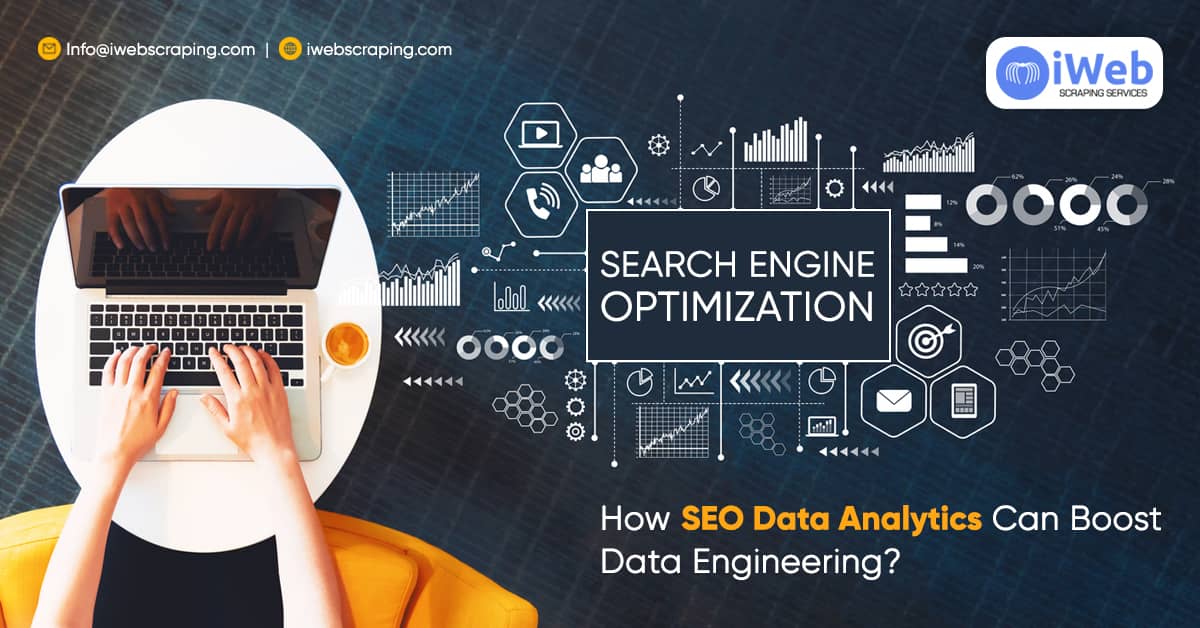How SEO Data Analytics Can Boost Data Engineering?

According to the most recent figures, the internet currently contains approximately 7 Zettabytes of data. For instance, we upload 576,000 hours of video to YouTube daily; Social meida has billion daily active users who submit images and videos virtually hourly, and we will soon produce a lot more data.
The majority of internet traffic now is generated by mobile devices, and an astounding 77% of Americans, according to the Pew Research Center, own a smartphone.
On the first Google search page, the top 5 organic results account for 67.6% of all clicks. The subsequent ones, which fall between six and ten, barely total up to 3.73%. A well-designed SEO data analytics plan can have a huge impact and have a great deal of potential for success.
In simple terms, SEO refers to the ranking that search engine give to websites depending on their accumulated data. The same website may appear in multiple search results for different search phrases.
There is no way to "game the system" because search engines don't utilize a set of guidelines or algorithms to rank web pages. Data science for SEO can only provide you with in-depth analysis of your approach and ongoing improvement.
Defining Data Science and Its Components

When it comes to analyzing and processing the data known as datasets, it is a science of dealing with data.
Data science building blocks:
- Domain Knowledge
- Data Engineering
- Accelerated Computing
- Analytics
- Graphics
How Data Science is Used for Monitoring SEO?

1. Consumer Behavior's Analysis
Customer opinions and behavior ultimately influence business decisions. Finding the right keywords to target is the first step in optimizing your data engineering SEO approach. Searching for the keywords might not be tough, but narrowing the list to the relevant terms may take some time. Ubersuggest, BuzzSumo, and SRMrush are a few applications that assist businesses in learning which search phrases are most popular.
Additionally, you can scrape information from social networking networks or even leverage Twitter's APIs, which provide developers access to public data aggregates. As a result, NLP-based systems can determine trends and keywords based on this data.
Imagine to develop a brand surrounding eco-friendly packaging. Consider you accept jute bags as alternatives to paper or may be plastic. In that case, you can utilize this data to inform your business policies.
To learn more about what people most frequently associate terms like "packaging," "sustainable," "eco-friendly," and "climate change" with, search for tweets using those hashtags.
You might develop a brand-new line of jute packaging and other products or utilize a superior material you could sell as jute's rival. As a result, folks looking for jute, jute bags, or jute packaging ought to find your site in the top searches.
2. Identified and Connected Content
Many companies that sell goods or services have blogs that publish new information regularly. This information could be about products the business offers or industry-related subjects. These aid in raising the web pages' score of SEO information analytics and improve their relevance to various keywords and search term. As long as you have the right tools, you can get content score.
- Proper keywords, both primary and secondary
- Follow specific basic guidelines, such as using active voice and short words.
To increase engagement, you can quickly publish new content. These articles' data analytics can assist you in understanding the following:
- Which articles' sections received the most views,
- What search terms people used to find these pages,
- What elements, if any, were duplicated, and much more?
These results will be helpful as you write blog articles and other copy for banners, landing pages, and product details.
3. Competitor Research
We strongly recommend using a DaaS service like iWeb Scraping to scrape data from social media and other websites. It took Rome a long time to build, and it will take time to be at the top of search engine results pages. Once the significant difficulties have been addressed, and your bases are covered, you might scrape information from your competitors ranks higher.
4. Enhancing the UX
Search Engine Paper highlights the primary User Experience numbers that Google tracks in this article. These metrics play important role in your SEO ranking. You must ensure that website contains the below three elements in place:
- The primary content of your website must load in less than 2.5 seconds when people first access it.
- The first time someone interacts with your site, there should be a maximum of a 100ms delay.
- A page's first load time shift should be, at most, 01. Factor.
5. Accessibility on Mobile
Approximately 54% of web traffic in the fourth quarter of 2021 came from mobile devices. Given the popularity of increasingly compact mobile phones for online browsing, a website's mobile friendliness significantly impacts its SEO ranking. Mobile devices and laptops might use the same APIs, but the look and feel might differ. The most frequent problems are:
- On small devices, the text and photos distort.
- Screens in apps take too long to load.
- Images load more slowly than pages do.
Regularly monitoring many metrics for each website visit is necessary to address these concerns. You can use an algorithm to process data automatically and prioritize issues.
6. Statistics of SEO and Content Marketing
There has always been a close relationship between SEO and content marketing. But as search engines become more content-driven, the distinction between the two has grown even hazier.
Your marketing approach will work like magic with data-driven content for SEO. The most crucial ranking variables for organic results are conversions and user engagement. Online visitors anticipate individualized engagement as part of their conversions, and nearly 64% do. A website can be SEO-optimized, but it will only be valid if supported with user-focused and quality content. You must therefore produce material that appeals to users. And you need data for it.
The goal of data-driven content marketing is to create content tailored to the wants and needs of your target audience based on their preferences. Creating a content strategy lessens your reliance on assumptions and improves the performance of your website's content.
You are better prepared to provide content that engages your prospects and influences user behavior metrics when you know the kind of content your users prefer, the tones they prefer, and other minute nuances.
Impact of Big Data on SEO

Big Data is a term used to describe the enormous amounts of organized and unstructured data constantly inundating an organization. You must comprehend how Big Data and SEO are associated if you're going to make effective use of all this information.
Google is the largest Big Data company in the world. Throughout its history, Google has accumulated a lot of data, developed automated interfaces, and given its clients information, explains SEO specialist Jiyan Wei in Search Engine Land.
All of this information will impact searches in the future. As a result, it will also influence how businesses optimize their websites and content. Small businesses can compete with industry giants through carefully considered content strategies with the help of big data.
Conclusion
Building a clear, accessible, and intuitive website can last a long time. However, SEO data analytics tactics do alter with time. Your website's content will determine the ranks for particular keywords and phrases. You are more likely to receive a high SEO ranking if consumers enjoy using and finding your website.
Contact iWeb Scraping if you are looking for any web scraping services.
Request for a quote!
